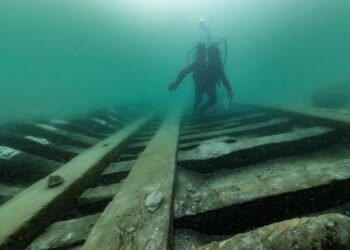Researchers have unearthed the well-preserved skeleton of a man with a sophisticated iron prosthetic hand, in Freising, Bavaria, Germany. The find was made during pipeline excavation near the St. George parish church.

The prosthetic hand, made of iron and non-ferrous metal, replaces four missing fingers on the left hand, showcasing the ingenuity of medical practitioners of that era.
The skeleton, estimated to be that of a man aged between 30 and 50, dates back to the period between 1450 and 1620. Dr. Walter Irlinger, head of the conservation department at the Bavarian State Office for Monument Preservation (BLfD), noted, “Even for experienced archaeologists, this was a particularly special find: a skeleton in which parts of the fingers of its left hand are missing.”
The prosthetic hand, composed of individually crafted sheet metal fingers (index, middle, ring, and little fingers), is immobile and likely secured to the stump with straps.

Dr. Irlinger further explained, “The finger replicas lie parallel to each other, slightly curved. Presumably, the prosthesis was tied to the stump of the hand with straps.” Radiocarbon dating revealed the man’s death occurred during a period marked by military conflicts between 1450 and 1620.
The purpose behind the amputation and the specific use of the prosthetic remain mysteries. Although the thumb of the hand was preserved, the circumstances leading to the amputation are yet to be deciphered. Archaeologists discovered a thumb bone corroded on the inside of the prosthesis.
Moreover, initial scans exposed traces of fabric and leather, indicating the possibility of a covering for the prosthetic fingers. Inside the iron hand, a gauze-like textile was identified, suggesting an effort to pad the hand stump for increased comfort.
Dr. Irlinger emphasized the significance of the discovery, stating, “Already at that time, doctors thought about how they could make life easier for amputees.” This sentiment reflects a broader historical context, considering the approximately 50 similar prostheses discovered across Central Europe from the late Middle Ages to the early modern age.
Freising, a city with historical significance and the site of various military conflicts, including the Thirty Years’ War (1618-1648), likely experienced increased amputations during these tumultuous periods. Such conflicts contributed to the demand for prosthetic devices, as evident in the archaeological findings.

This particular prosthetic hand, distinct from others found in the region, stands out for its simplicity and lack of mechanical components. In contrast, famous figures like Götz von Berlichingen, a knight who lost his right hand during the siege of Landshut in 1504, wore more complex and mobile prosthetics.























